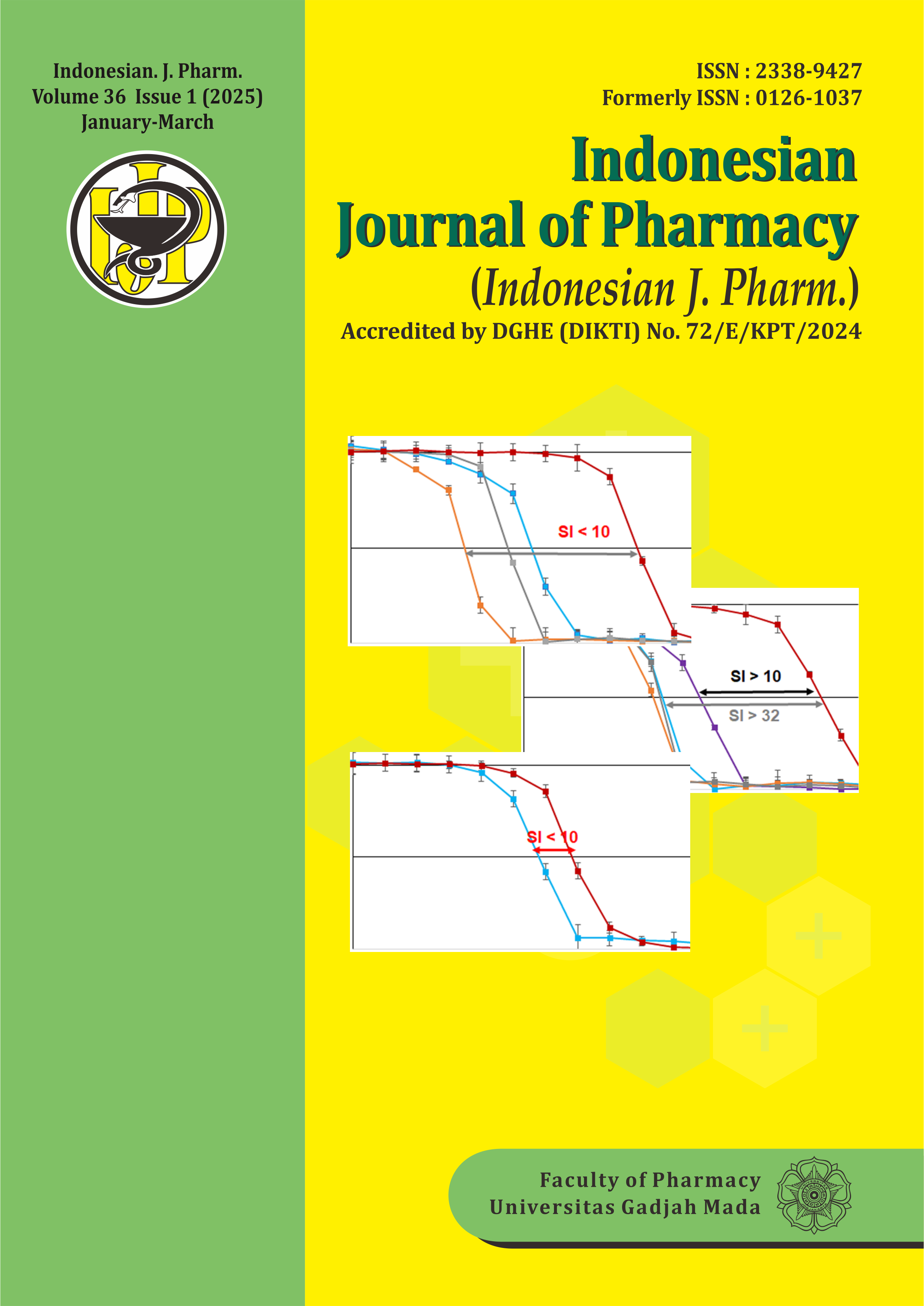Formulation of Cinnamon Essential Oil (Cinnamomum burmannii) and Clove Essential Oil (Syzygium aromaticum) Nanoemulsion-Based Liquid Soap
Abstract
Soap is a cosmetic that acts as a cleaning agent, to protect the body from various diseases, such as skin diseases caused by bacteria and fungi. One of the bacteria that causes infection is Staphylococcus aureus. The eugenol content in cloves and cinnamaldehyde in cinnamon can inhibit the growth of bacteria. This research aims to determine the liquid soap formulation based on a nanoemulsion combination of clove and cinnamon essential oils that meets the physicochemical characteristics and its activity in inhibiting the growth of S. aureus bacteria using the diffusion method. The research results showed that clove and cinnamon essential oils had antibacterial activity, with the concentration of clove essential oil used being 2% and cinnamon essential oil 3%. Then it was formulated into a nanoemulsion with a composition ratio of Tween 80 and PEG 400 as the most optimal surfactant and cosurfactant of 40:10. The nanoemulsion is formulated into liquid soap where the nanoemulsion combination of clove and cinnamon essential oils is added to the liquid soap base. The resulting liquid soap has good physicochemical properties and meets the requirements.
References
Asri, I.H., Lestarini, Y., Husni, M., Muspita, Z., dan Hadi, Y.A., 2021, Edukasi Pola Hidup Sehat Di Masa Covid-19. Abdi Populika, 2(1): 56–63.
Aqmarina, M.B., Priani, S.E., dan Gadri, A., 2016, Uji Aktivitas Antibakteri Minyak Kayu Manis (Cinnamomum burmanni Nees ex Bl.) terhadap Bakteri Staphylococcus aureus Penyebab Jerawat. Prosiding Farmasi, 2(2): 433–438.
Badan Standardisasi Nasional, 1994. Standar Mutu Sabun Mandi, dalam: SNI 06-3532-1994. Dewan Standardisasi Nasional, Jakarta.
Badan Standardisasi Nasional, 1996. Standar Sabun Mandi Cair, dalam: SNI 06-4085-1996. Dewan Standardisasi Nasional, Jakarta.
Balakumar, K., Raghavan, C.V., Selvan, N.T., Prasad, R.H., dan Abdu, S., 2013. Self-Nanoemulsifying Drug Delivery System (SNEDDS) of Rosuvastatin Calcium: Design, Formulation, Bioavailability and Pharmacokinetic Evaluation. Colloids and Surfaces B: Biointerfaces, 112: 337–343.
Chasani, M., Widyaningsih, S., dan Sony, I., 2022, Variasi Kadar Sodium Lauryl Sulfate terhadap Karakteristik Sabun Antibakteri Berbahan Dasar Minyak Biji Nyamplung (Calophyllum Inophyllum) Dengan Bahan Aditif Ekstrak Temu Giring (Curcuma Heyneana). Jurnal Ilmiah Multidisiplin, 1(8): 2535–2549.
Einien, M.A., Mahrouq, G.E., dan Elkasabgy, N., 2012. Design and In-Vitro Evaluatuon of Olanzapine-Loaded Self Nanoemulsifying Drug Delivery System. International Journal of Institutional Pharmacy and Life Sciences, 2: 12–32.
Hambali, E., Suryani, A., Rivai, M., dan Permadi, P., 2019, Teknologi Surfaktan dan Aplikasinya, Edisi Revisi, 204. IPB Press, Bogor.
Huda, M., Rodhiansyah, dan Ningsih, D.S., 2018, Efektivitas Ekstrak Bungan Cengkeh (Eugenia aromatica) terhadap Pertumbuhan Bakteri Staphylococcus aureus. Jurnal Analis Kesehatan, 7(1): 710–716.
Meliana, Y., 2022, Peran Teknologi Nanoemulsi untuk Pengembangan Mutu Kosmetik dari Herbal Asli Indonesia, 14. Badan Riset dan Inovasi Nasional (BRIN), Jakarta.
Oshomoh, E.O., Idu, M., dan Udinyiwe, O.C., 2015, Phytochemical Screening and Antimicrobial Sensitivity of Clove Flower (Syzygium aromaticum, L. Merrill and Perry) Bud on Dental Pathogens. International Journal of Pharmacy & Pharmaceutical Research (IJPPR), 3(2): 1–13.
Patel, J., Kevin, G., Patel, A., Raval, M., dan Sheth, N., 2011a. Design and development of a self-nanoemulsifying drug delivery system for telmisartan for oral drug delivery. International Journal of Pharmaceutical Investigation, 1: 112.
Patel, J., Patel, A., Raval, M., dan Sheth, N., 2011b. Formulation and development of a self-nanoemulsifying drug delivery system of irbesartan. Journal of Advanced Pharmaceutical Technology & Research, 2: 9.
Purnamaningsih, N.A., Kalor, H., dan Atun, S., 2017, Uji Aktivitas Antibakteri Ekstrak Temulawak (Curcuma Xanthorrhiza) terhadap Bakteri Escherichia coli ATCC 11229 dan Staphylococcus aureus. Jurnal Penelitian Saintek, 22(2): 140–147.
Radiastuti, N., Sukandar, D., dan Khotimah, F.K., 2011, Efektivitas Antibakteri Minyak Atsiri Bunga Cengkeh (Syzygium arimaticum) terhadap B. subtilis, B. cereus, S. aureus, E. coli, dan P. aeruginosa Serta Isolasi Senyawa Aktifnya. Berk Penel Hayati Edisi Khusus, 4: 31–35.
Rasyadi, Y., Yenti, R., dan Jasril, A.P., 2021, Efek Antibakteri Sabun Mandi Cair Ekstrak Buah Kapulaga terhadap Staphylococcus aureus. Journal Uhamka, 8(1): 1–6.
Rinaldi, Elfariyanti, dan Mastura, R., 2021, Formulasi Sabun Cair dari Ekstrak Etanol Serai Wangi (Cymbopogon nardus L.). Jurnal Sains dan Kesehatan Darussalam, 1(1): 29–36.
Sagar, K., Kendre, P., Pande, V., dan Chaudhari, V., 2014. Design, Development and Characterization Self-Nanoemulsifying Drug Delivery System (SNEDDS) of Nateglinide. World Journal of Pharmacy and Pharmaceutical Sciences, 3: 794–811.
Sari, S.A., Firdaus, M., Fadilla, N.A., dan Irsanti, R., 2019, Studi Pembuatan Sabun Cair dari Daging Buah Pepaya (Analisis Pengaruh Kadar Kalium Hidroksida terhadap Kualitas Sabun). Talenta Conference Series: Science and Technology (ST), 2(1): 60–65.
Syamsudin, 2016, Formulasi Losio Emolien dari Ekstrak Etanol Sarang Semut (Myrmecodia pendens) dengan Menggunakan Emulgator Anionik dan Nonionik. Journal of Pharmaceutical and Medicinal Sciences 2016 1(2): pp 79-82.
Waty, S., Suryanto, D., dan Yurnaliza, 2018, Antibacterial Activity of Cinnamon Ethanol Extract (Cinnamomum burmannii) and Its Application as a Mouthwash to Inhibit Streptococcus Growth. IOP Conf. Series: Earth and Environmental Science, 130: 1–7.
Yuan, C.L., Xu, Z.Z., Fan, M.X., Liu, H.Y., Xie, Y.H., dan Zhu, T., 2014, Study on Characteristics and Harm of Surfactants. Journal of Chemical and Pharmaceutical Research, 6(7): 2233–2237.
Zulkarnain, A.K., Marchaban, M., Wahyuono, S., and Susidarti, R. A. 2015. SPF In Vitro and the Physical Stability of O/W Cream Optimal Formula from the Partition Product of Mahkota Dewa (Phaleria macrocarpa (Scheff) Boerl). Indonesian Journal of Pharmacy, 26(4), 210–218.








